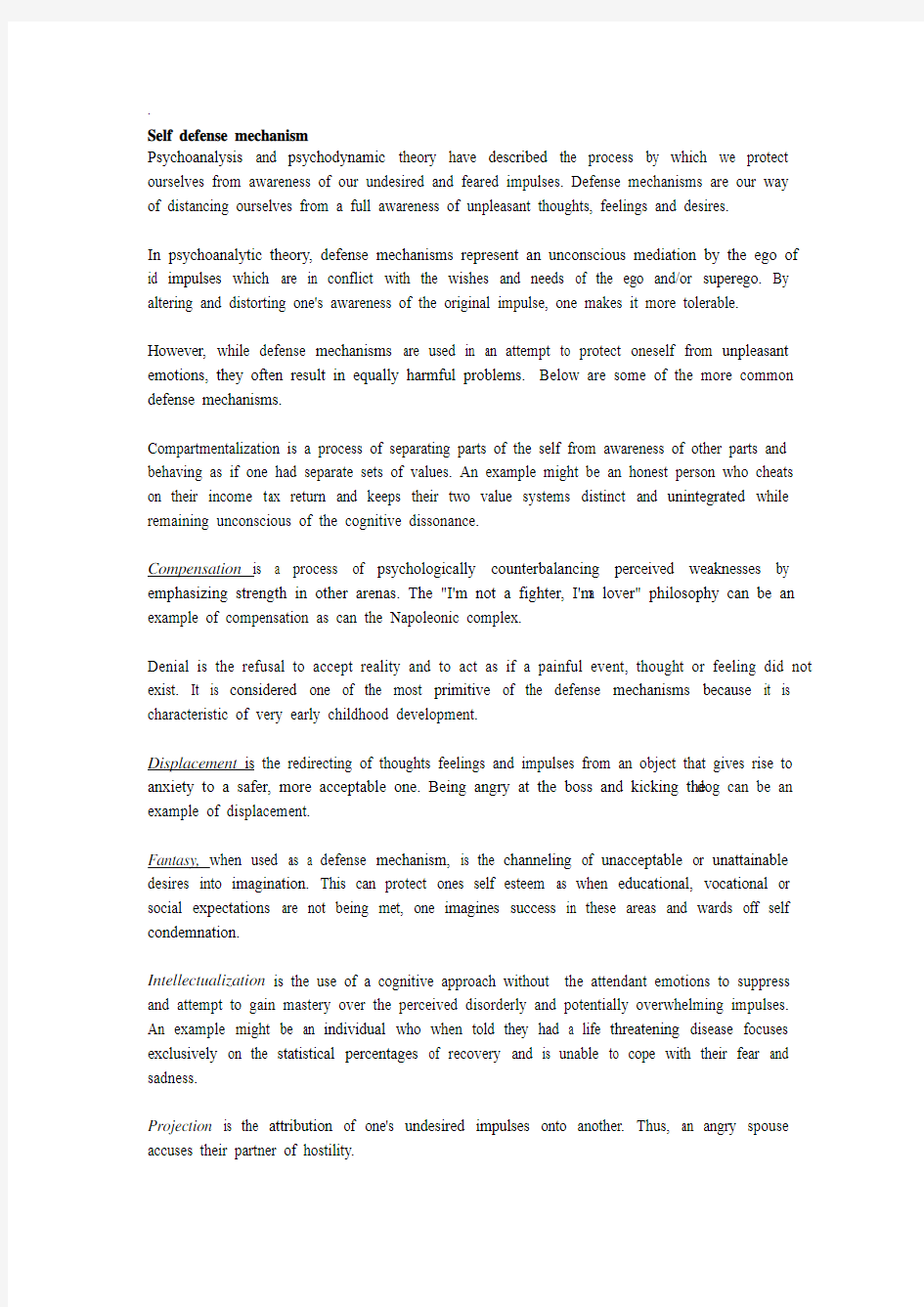DEFENSE MECHANISM


Self defense mechanism
Psychoanalysis and psychodynamic theory have described the process by which we protect ourselves from awareness of our undesired and feared impulses. Defense mechanisms are our way of distancing ourselves from a full awareness of unpleasant thoughts, feelings and desires.
In psychoanalytic theory, defense mechanisms represent an unconscious mediation by the ego of id impulses which are in conflict with the wishes and needs of the ego and/or superego. By altering and distorting one's awareness of the original impulse, one makes it more tolerable.
However, while defense mechanisms are used in an attempt to protect oneself from unpleasant emotions, they often result in equally harmful problems. Below are some of the more common defense mechanisms.
Compartmentalization is a process of separating parts of the self from awareness of other parts and behaving as if one had separate sets of values. An example might be an honest person who cheats on their income tax return and keeps their two value systems distinct and unintegrated while remaining unconscious of the cognitive dissonance.
Compensation is a process of psychologically counterbalancing perceived weaknesses by emphasizing strength in other arenas. The "I'm not a fighter, I'm a lover" philosophy can be an example of compensation as can the Napoleonic complex.
Denial is the refusal to accept reality and to act as if a painful event, thought or feeling did not exist. It is considered one of the most primitive of the defense mechanisms because it is characteristic of very early childhood development.
Displacement is the redirecting of thoughts feelings and impulses from an object that gives rise to anxiety to a safer, more acceptable one. Being angry at the boss and kicking the dog can be an example of displacement.
Fantasy, when used as a defense mechanism, is the channeling of unacceptable or unattainable desires into imagination. This can protect ones self esteem as when educational, vocational or social expectations are not being met, one imagines success in these areas and wards off self condemnation.
Intellectualization is the use of a cognitive approach without the attendant emotions to suppress and attempt to gain mastery over the perceived disorderly and potentially overwhelming impulses. An example might be an individual who when told they had a life threatening disease focuses exclusively on the statistical percentages of recovery and is unable to cope with their fear and sadness.
Projection is the attribution of one's undesired impulses onto another. Thus, an angry spouse accuses their partner of hostility.
Rationalization is the cognitive reframing of ones perceptions to protect the ego in the face of changing realities. Thus, the promotion one wished fervently for and didn't get becomes "a dead end job for brown nosers and yes men".
Reaction Formation is the converting of wishes or impulses that are perceived to be dangerous into their opposites. A woman who is furious at her child and wishes her harm might become overly concerned and protective of the child's health.
Regression i s the reversion to an earlier stage of development in the face of unacceptable impulses. For an example an adolescent who is overwhelmed with fear, anger and growing sexual impulses might become clinging and begin thumb sucking or bed wetting.
Repression is the blocking of unacceptable impulses from consciousness.
Sublimation is the channeling of unacceptable impulses into more acceptable outlets.
Undoing is the attempt to take back behavior or thoughts that are unacceptable. An example of undoing would be excessively praising someone after having insulted them.
在弗洛伊德的精神分析理论中,人格主要是由三部分组成——本我(id)、自我(ego)和超我(superego)。本我潜藏于人格的最底层,储藏着生物性的原始驱力,遵循的是“快乐原则”;而超我则储藏着个体的价值观和道德感,是一种与社会化相关的理想自我。可见本我与超我之间几乎是处于人格结构的两个极端,二者之间的冲突常常会导致各种心理冲突甚至是人格障碍。而基于“现实原则”的自我则在这二者之间实现这调和的功能。
自我防御机制(ego defense mechanisms)即是指自我在寻求表现的本我冲动与否定它们的超我要求之间的日常冲突中,用来保护自身,维持平衡的心理策略。主要包括以下几种形式:
1.对现实的否认——为保护自我拒绝承认不愉快的现实。
这种现象通常出现在突发的灾难性事件之后,如心爱的人身亡却相信其还活着,或者被医生告知自己身患绝症却坚持是误诊等等。否认可以说是一种对于痛苦的逃避,对个体的具有一定的保护作用,它可以对我们接受现实起到一定缓冲。
2.置换——将敌意等强烈的情感从最初唤起情绪的目标转移到较少危险的另一目标,以减轻心理负担取得心理安宁。
如一个孩子被妈妈打后,来自本我的愤怒发泄与超我的道德约束产生矛盾,于是转而踢倒身边的板凳。这时情绪释放的客体发生改变,但其冲动的性质与目的并未改变。置换可能是在意识状态下发生,也有可能是无意识的。在心理治疗中,其既是移情的基础,也是反移情的基础。
3.幻想——用想象的方式满足受挫的欲望(常见形式如白日梦)。可认为是对本我在现实情景中的一种补偿。
4.认同——通过把自我与他人或制度等同,以增加自我价值感,常常是虚幻的表达。
一般表现在将他人的长处归为己有,作为自身的一部分去表达,借以排除焦虑以达
到适应。常见的形式如高官显贵的子女长以父辈之尊为己尊,以此抬高身价,避免尴尬场面,或者个体在面临困难时以某著名英雄为楷模,以此激励自己,或者对某些上级制度或社会规范予以肯定并执行等。
5.分离——将情感与伤害性的情景分开,或把相互矛盾的态度分离为有逻辑关系的不同成分(同时又持有相互冲突的态度,但它们从未被同时想起,或从未认为它们之间有什么关系);也称为分隔。
6.投射——把对困难的抱怨归于他人,或把自己不被允许的欲望归于他人。
这在婴儿时期可被认为是相对正确的,但成年人则有可能因为过度地歪曲现实而造成偏执与妄想。
7.合理化——试图证明一个人的行为是合理的、公正的,以证明自我和他人的价值感。
合理化有两种表现:一种是酸葡萄心理,即把得不到的东西说成是不好的;另一种是甜柠檬心理,即得不到葡萄而只有柠檬时,就说柠檬是甜的。
8.反向形成——通过认同相反的态度和行为类型,把它们作为屏障,以防止危险欲望的表达。
如一个有强烈性冲动压抑的人很可能会积极参与到禁止淫秽读物或音像制品的活动中。
9.退行——退回到以前的发展水平,包括更幼稚的反应以及较低水平的愿望。一般在个体的应激过程中较为常见。
10.压抑——是最基本的防御机制,即将痛苦或危险的想法排除在意识之外使不被觉知。
经压抑之后的观念和情感多被储藏于无意识当中,一般很难进行随意的回忆,但其却会在一定情景下以其它伪装的形式释放出来。如对痛苦时间或创伤性体验的选择性遗忘就是压抑的一种。
11.升华——将受挫的性欲望以社会文化认可的非性活动来满足。
这种机制可以把不被社会所认可的性欲与攻击性冲动的能量来源力比多(libido)转向更高级,社会所接纳和赞许的目标或渠道。这是一种最具有积极和建设性意义的防御机制,也是对本我与超我之间冲突进行平衡的正向体现。
对自我防御机制的评价:
自我防御机制形式多样,从不同角度还可分为成熟性防御&不成熟防御,积极防御&消极等,个人认为它们主要具有以下的一些特点和作用:虚幻性(甚至具有欺骗性)、歪曲性、无意识、保护与平衡作用。这些机制作为自我一种调和的实现,对个体的心理健康具有积极意义,但如果过多或者不正确的使用将可能产生更多的负性影响,甚至导致人格障碍.
